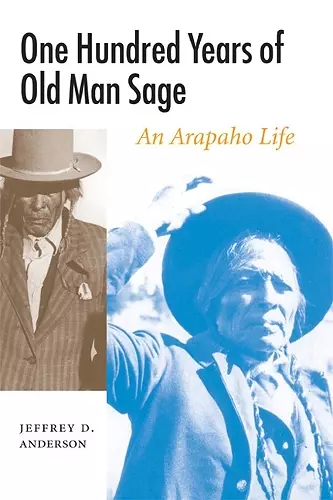One Hundred Years of Old Man Sage
An Arapaho Life
Format:Paperback
Publisher:University of Nebraska Press
Published:1st Sep '07
Currently unavailable, and unfortunately no date known when it will be back

Sherman Sage (ca. 1844-1943) was an unforgettable Arapaho man who witnessed profound change in his community and was one of the last to see the Plains black with buffalo
Sherman Sage (ca 1844-1943) was an Arapaho man who witnessed profound change in his community and was one of the last to see the Plains black with buffalo. The author gathered information about Sage's life from archives, interviews, recollections, and published sources and has here woven it into a biography.Sherman Sage (ca. 1844–1943) was an unforgettable Arapaho man who witnessed profound change in his community and was one of the last to see the Plains black with buffalo. As a young warrior, Sage defended his band many times, raided enemy camps, saw the first houses go up in Denver, was present at Fort Laramie for the signing of the 1868 treaty, and witnessed Crazy Horse’s surrender. Later, he visited the Ghost Dance prophet Wovoka and became a link in the spread of the Ghost Dance religion to other Plains Indian tribes. As an elder, Old Man Sage was a respected, vigorous leader, walking miles to visit friends and family even in his nineties. One of the most interviewed Native Americans in the Old West, Sage was a wellspring of information for both Arapahos and outsiders about older tribal customs. Anthropologist Jeffrey D. Anderson gathered information about Sage’s long life from archives, interviews, recollections, and published sources and has here woven it into a compelling biography. We see different sides of Sage—how he followed a traditional Arapaho life path; what he learned about the Rocky Mountains and Plains; what he saw and did as outsiders invaded the Arapahos’ homeland in the nineteenth century; how he adjusted, survived, and guided other Arapahos during the early reservation years; and how his legacy lives on today. The remembrances of Old Man Sage’s relatives and descendants of friends make apparent that his vision and guidance were not limited to his lifetime but remain vital today in the Northern Arapaho tribe.
"Anderson, reflecting the fruits of his longtime residence and advocacy in a contemporary Native community, presents a model of ethnohistory and analysis that gives a fascinating account of a man who witnessed and adapted to major cultural changes. . . . This is a worthy book."—Choice
"Sage's experiences were significant not only because of his longevity, but also because of his willingness to share his knowledge and history with anthropologists and others. . . . Anderson has performed admirable work in piecing together existing narratives and his own research to produce a worthwhile study."—Mary Ellen Tunks, Montana the Magazine of Western History
“Anderson has produced an analytical biography that acquaints readers with some of the best insight Arapaho culture has to offer.”—Billy Hathorn, South Dakota History
"A most welcome contribution to the study of American Indian history and ethnology."—Henry E. Stamm IV, Western Historical Quarterly
ISBN: 9780803222403
Dimensions: unknown
Weight: 255g
140 pages